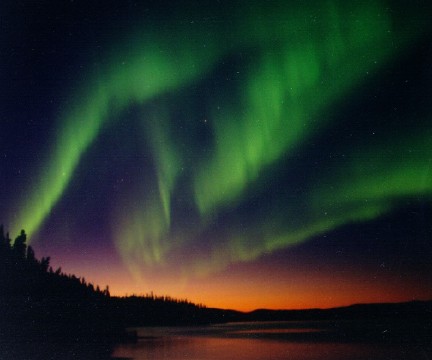Probing the Terrestrial Ionosphere
![]()
Hello fellow physics buff and web surfer! Every day our planet is
bombarded by energetic debris which was once part of the Mass of our Sun.
As the Sun 'burns' it sends particles of 'solar ash' streaming out
spherically in all directions. These particles move out into our solar
system and the Earth's orbit sweeps through this path of debris. Due
to giant solar flares and sunspots this 'dust stream' is constantly changing
and moves with a varying velocity of less than 200 to over 600 kilometers
per second, with densities ranging from under 2 to over 8 protons/cm3.
As the Earth passes through this solar windstorm, our planets' natural magnetic
poles deflect the paths of some of this debris; (concentrated by the Earths'
magnetic flux fields) some streams in close enough to interact with our
protective atmosphere and causes the phenomenon that we call the
Aurora Borealis

copyright 1995 jancurtis
![]()
For an up to the minute summary of the solar winds, geomagnetic
flux field changes, space weather storms forecasts, and an aurora report
I enjoy the HAM radio based: http://dx.qsl.net/propagation/index.html
These folks say they have "A dynamic collection of propagation information
gathered from many different sources". Be sure to examine the photos
of the Sun exposed at differing light frequencies!
Radio Techniques
Some of the earliest radio pioneers realized that the propagation of their signals depended on electromagneticly reflective layers in the atmosphere. It was determined experimentally that various frequencies are reflected at different angles throughout the ionosphere, and these signals will travel to different locations around the earth. It was not long until the connection was made between varying propagation anomalies and the various cycles that our sun was known to go through. We now not only study the ionosphere with amateur radio operators, but universities and governments worldwide have committed resources to study propagation to enhance 'cave' radio, underwater communications with submarines, and of course orbiting data relay and 'spy' satellites.
The first continuous radio beacons gave birth to what is called the vertical
ionosode. Radio energy is beamed vertically and monitored for reflecting
and scattering effects. The equipment used has developed into
higher frequency components with the advent of newer technologies.
Today frequencies are used up into, and even over, the visible light
frequencies. Check out the LIDAR information right here at Poker
Flats research range outside of Fairbanks. http://www.pfrr.alaska.edu/
Ionospheric Heating is a technique where radio waves are concentrated
on a specific point in the sky, and the RF energy tends to 'Heat' the area
and increase the energy level of the ionosphere. This changes the ionosphere
much like a sunspot or solar flare. Experiments are continuing "with
particular emphasis on being able to understand and use it to enhance communications
and surveillance systems for both civilian and defense purposes." ( http://www.haarp.alaska.edu/
) The HAARP site has an excellent virtual tour , with lots of
background information (see the general info section). In addition
you can access their data online in real time as they perform heating experiments,
and most of the receivers are operated continuously monitoring the natural
background radiation.
Another technique is called 'Incoherent Scatter Radar'. This
method of ionospheric study came out of the cold war between the United
States and the U.S.S.R. Long range over the horizon RADAR sites originally
used to monitor for incoming ICBMs are still transmitting,( http://superdarn.jhuapl.edu/) and
the reflected signals are monitored for atmosphereic changes at the transmission
site and several receiving stations throughout the world. Some of
this equipment is functioning so well that even gravitational changes can
be detected.
In addition to ground based methods, many hundreds of satellites are now orbiting
our planet. The very first manmade satellite, Sputnik I, was simply
a beep- beep- beep radio transmitter used to study radio propagation down
to earth from above. These signals were received by american
ham radio operators before our military knew Sputnik was airborne.
The success of this flight paved the way for the systems of GPS, television,
and communications satellites that we use today. To check the location
of your favorite satellite, including the International Space Station
and Shuttle ( when in orbit) I like : http://science.nasa.gov/realtime/JTrack/Spacecraft.html
This site offers both a two dimensional 'customizable' satellite display,
and a 3-D option that lets you view the entire earth and satellite orbits
in real time. By clicking on any of the 'dots' the satellite information
will be displayed.
![]()
dx.qsl.net/propagation. 20 November 2004. <http://dx.qsl.net/propagation/index.html>
Poker Flats Research Range. 21 November 2004. <http://www.pfrr.alska.edu/>
Highfrequency Active Auroral Resarch Project. 20 November 2004. <http://www.haarp.alaska.edu/>
Super Dual Aurora Radar Network. 21 November 2004. <http://superdarn.jhuapl.edu/>
Spacecraft J-Track. 21 November 2004. <http://science.nasa.gov/realtime/JTrack/Spacecraft.html>
You may e-mail me: fsrwj@uaf.edu